 W
WIn 1833, following the end of the Belgian Revolution, the young kingdom of Belgium created the Iron Cross to recognise wounds received and bravery in battle. The award first class was bestowed to the wounded who elected to stay at their post and keep fighting, to the maimed and mutilated, as well as for acts of courage, the award second class was bestowed to all wounded combatants. In 1835, due to the discontent of most recipients, the award 2nd class was terminated and all received the first class. Over the years, recipients of the Iron Cross received ever increasing pensions, up to ten years of seniority when employed as civil servants and pensions for the widows and orphans of the deceased. The other combatants of 1830-1831 received no pension, and no commemorative medal was struck.
 W
WThe 1870–71 Commemorative Medal was a Belgian campaign medal established by royal decree on 20 September 1911 and awarded to all members of the Belgian Army who were mobilized during the period from 15 July 1870 to 5 March 1871 during the Franco-Prussian War.
 W
WThe Commemorative Medal of the African Campaigns 1914–1917 was a Belgian military war service medal established by Royal Decree on 21 February 1917 to recognise combat service on the African continent between 1914 and 1918.
 W
WThe Commemorative Medal of the 1914–1918 War was a Belgian commemorative war medal established by royal decree on 21 July 1919 and awarded to all members of the Belgian Armed Forces who served during the First World War that were eligible for the inter-allied victory medal.
 W
WThe 1940–1945 African War Medal was a Belgian war service medal established by royal decree of the Regent on 30 January 1947 and awarded to officers and soldiers for at least one year's service in the Force Publique between 10 May 1940 and 7 May 1945. This service was not limited to the Belgian colonies of the Congo and Ruanda-Urundi but also included the Middle East, Nigeria, Madagascar and Burma, for which clasps were awarded for six months service in those areas.
 W
WThe 1940–1945 Military Combatant's Medal was a Belgian war medal established by royal decree on 19 December 1967 and awarded to all members of the Belgian Armed Forces who fought from the United Kingdom during the Second World War.
 W
WA Brevet d'état-major, commonly abbreviated to BEM, is a military distinction in France and Belgium which denotes that an officer has passed the École de guerre, the French Staff College. Though it is usually only seen in French, it can be abbreviated to SBH in Dutch. Between 1870 and 1940, an officier breveté was a graduate of the École supérieure de guerre.[3] Nowadays, while many officers still attend the école de guerre, they do not use the term officier breveté.
 W
WThe Centenary of National Independence Commemorative Medal 1830-1930 was a Belgian commemorative medal established by royal decree on 20 July 1930 to commemorate the 100th anniversary of Belgian independence.
 W
WThe Commemorative Medal for Armed Humanitarian Operations is a military decoration of Belgium. It was established on 11 September 1987 and is awarded to military and civilian members of the Belgian Armed Forces who participated in armed humanitarian operations.
 W
WThe Commemorative Medal for Foreign Operations or Missions is a military decoration of Belgium. It was established on 13 April 1993 and is awarded to military and civilian members of the Belgian Armed Forces who participated in operations or missions outside of the territory of Belgium.
 W
WThe Commemorative Medal for Missions or Operations regarding the operational defense of the territory is a military decoration of Belgium. It was established on 28 March 2018 and is awarded to military and civilian members of the Belgian Armed Forces who participated in operations related to the defense of the Belgian territory or who provided specialized support to such operations.
 W
WThe Commemorative Medal of the Reign of King Albert I was a Belgian military medal established on 17 February 1962 to commemorate the reign of Albert I of Belgium.
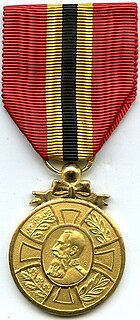 W
WThe Commemorative Medal of the Reign of King Leopold II was a Belgian civilian and later military and police forces medal originally established on 21 July 1905 by royal decree to commemorate the 40th year of the reign of King Leopold II.
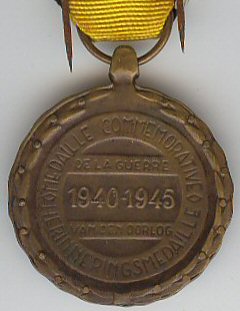 W
WThe Commemorative Medal of the 1940–45 War was a military decoration of Belgium. It was established by royal decree of the Prince Regent on 16 February 1945 to recognise Belgian servicemen and women who served during World War II. It was also awarded to members of the Belgian Resistance and members of Belgium's Merchant Navy on the side of the Allies. Later decrees allowed for its award to foreign recipients of the Belgian Croix de Guerre.
 W
WThe Commemorative Medals for Army Marches are two distinct medals awarded for participating in the two marches organised yearly by the Belgian Army. They are not decorations, but they may be worn by members of the Belgian Armed Forces on their uniform during the year following the participation if they request it. For members of the Belgian Army, participating in the marches counts as operational training.
 W
WThe Cross of Honour for Military Service Abroad is a Belgian military decoration originally established for award to Belgian servicemen who served for a long period of time in the Federal Republic of Germany, Zaire, Rwanda or Burundi. It was established on 16 June 1997 in three classes.
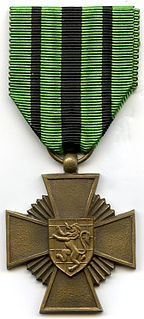 W
WThe Escapees' Cross 1940–1945 was a Belgian war service medal established on 25 February 1944 by the Belgian government in exile in London. It was awarded to all Belgian citizens who, during World War II, escaped from occupied Belgium, from another occupied land or from Germany and that, following said escape, had proven their patriotism by joining and serving with a resistance group, or had been imprisoned for a minimum of three months following an act of patriotism, or for having travelled clandestinely to participate in a Belgian action aimed at promoting the war against the enemy. Escaped prisoners of war could also be awarded the medal if they met this last criteria.
 W
WThe 1914 – 1918 Fire Cross was a Belgian military decoration awarded to all holders of the so-called "Fire Card" which was awarded to all who came under fire at the front during the First World War. The medal was established by royal decree on 6 February 1934. It could not be awarded posthumously.
 W
WThe Victory Medal is the Belgian variant of the Inter-Allied Victory Medal 1914–1918 was a Belgian commemorative war medal established by royal decree on 15 July 1919 and awarded to all members of the Belgian Armed Forces who served during the First World War. Later royal decrees enlarged the list of potential recipients to include service in African campaigns and under special circumstances, to members of the merchant navy and fishing fleet. In all, 350,000 were awarded.
 W
WThe Iron Cross was established by law in 1833 following the end of the Belgian Revolution to recognise serious wounds received and bravery in battle by Belgian citizens taking part in the fight for Belgian independence from the United Kingdom of the Netherlands between 25 August 1830 and 4 February 1831. A further royal decree of 22 August 1834 created a second class to the Iron Cross for award to all wounded combatants. Due to the lower perceived importance of the second class award and discontent among recipients, the Iron Cross second class was short lived and amalgamated to the Iron Cross first class by decree of 21 February 1835. All recipients now received the (original) first class award.
 W
WThe Liège Medal was an unofficial World War I campaign medal issued by the Belgian city of Liège to its 1914 defenders against the German invaders. It was first issued in April 1920 during a large ceremony presided by the Duke of Brabant and Lieutenant General the Count Gérard-Mathieu Leman, military commander of the defence of Liège during the battle which raged from the 5th to the 16th of August 1914. The stubborn defence of the city forced the Germans to bring in specialised extra heavy artillery to take on the city fortifications.
 W
WThe Maritime Medal 1940–1945 was a Belgian bravery award of World War II, established by Royal Decree on 17 July 1941 and awarded to members of the Belgian Navy, merchant navy or fishing fleet for acts of heroism in the saving of ships or lives during an action against the enemy.
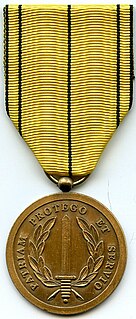 W
WThe Medal for Services Rendered is a Belgian military service medal that was proposed to be created on 18 April 1988 by ministerial decree. It was intended to be awarded to members of the army, navy, air force and medical services of the Belgian Armed Forces for service rendered in particularly difficult circumstances over an extended time period. However, the creation of the medal was presented to the Council of State under the form of a ministerial decree and the Council ruled that the creation of such an award should be done by the King, thus via a Royal Decree. As a Royal Decree was never adopted, the medal was never officially created and has not or cannot be awarded.
 W
WThe Resistance Medal 1940–1945 was a Belgian war medal established by royal decree of the Regent on 16 February 1946 and awarded to all members of the Belgian armed resistance during the Second World War and to members of the intelligence service who operated in occupied territories and participated in combat actions aimed at the liberation of Belgium.
 W
WThe Meritorious service medal for personnel of the Belgian Defence Forces and Foreign Armed Forces is a military decoration of Belgium. It was established on 23 February 2005 as a more rewarding successor of an earlier Medal of Military Merit and is awarded to members of the Belgian Armed Forces and civilians working for the Belgian Defence who show an exemplary meritorious behaviour in the completion of their duties or who have accomplished an exemplary meritorious act.
 W
WThe Military Decoration is a military award of the Kingdom of Belgium. It was established on December 23, 1873 and is awarded to non-commissioned officers and other ranks of the Belgian Armed Forces for gallantry or loyal and uninterrupted service.
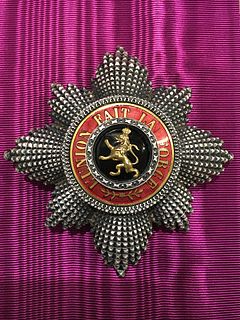 W
WThe Order of Leopold is one of the three current Belgian national honorary orders of knighthood. It is the oldest and highest order of Belgium and is named in honour of its founder; King Leopold I. It consists of a military, a maritime and a civil division. The maritime division is only awarded to personnel of the merchant navy, and the military division to military personnel. The decoration was established on 11 July 1832 and is awarded by Royal order.
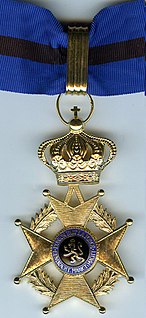 W
WThe Order of Leopold II is an order of Belgium and is named in honor of King Leopold II. The decoration was established on 24 August 1900 by Leopold II as Sovereign of the Congo Free State and was in 1908, upon Congo being handed over to Belgium, incorporated into the Belgian awards system. The order is awarded for meritorious service to the sovereign of Belgium, and as a token of his personal goodwill. It can be awarded to both Belgians and foreigners, and is seen as diplomatic gift of merit.
 W
WThe Prisoner of War Medal 1940–1945 was a Belgian war service medal established by royal decree on 20 October 1947 and awarded to all members of the Belgian Armed Forces imprisoned by Axis Forces during the Second World War.
 W
WThe Volunteer Combatant's Medal 1914–1918 was a Belgian wartime service medal established by royal decree on 17 June 1930 and awarded to Belgian citizens and foreign nationals who voluntarily enlisted for service in the Belgian Armed Forces during World War I.
 W
WThe Volunteer's Medal 1940–1945 was a Belgian war medal established by royal decree of the Regent on 16 February 1945 and awarded to Belgian and foreign civilians who voluntarily enlisted in the Belgian Armed Forces during the Second World War. The medal could also be awarded to volunteers serving in the Belgian units of the Royal Air Force, Royal Navy or British merchant navy.